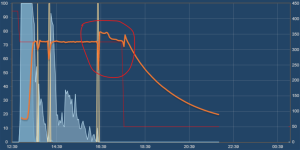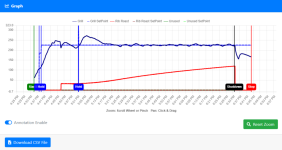Brett-EDH
TVWBB Olympian
Apple juice. Sorry about that.I searched the webs but couldn’t find it.
What is AJ?
Apple juice. Sorry about that.I searched the webs but couldn’t find it.
What is AJ?
Is the entire cook done in a foil pan? And on the WSK?This was last night- beef brisket.
The Weber cookbook advised cooking as close to 225 as possible and cook for 4 hours to 160, wrap with foil and cook for 6 more hours to 190-195.
I couldn’t get the low temp, and it cooked too fast in my opinion.
It tasted ok, but was a little tough at 7 hours total cook time.
Hence the thread:
View attachment 65421
Edit: I also mistakenly cooked the first leg fat side down - the recipe called for fat side up the whole cook. That probably didn’t help.
Ok- I have been using a lot of apple juice and apple cider vinegar on these cooks- I’ll try this method next time.Apple juice. Sorry about that.
Is the entire cook done in a foil pan? And on the WSK?
Interesting. It sounds like it cooked like an oven roasted brisket. I think that foil pan cook session held way too much heat around the brisket. Basically making an oven and killing the airflow.Ok- I have been using a lot of apple juice and apple cider vinegar on these cooks- I’ll try this method next time.
I used a foil pan for the overnight injected beef broth/ mustard rub and dry rub marinade.
Early the next morning I took the tray out of the refrigerator for about an hour. Once the grill was holding around 240 I put the tray on the grill for the first part of the cook..
After 3 hours/ 160 internal temperature I placed the brisket on three overlapped 3’ sections of heavy aluminum foil, partially folded it up, poured the drippings/ juice over it, inserted the digital thermometer probe into the thickest part, sealed it all up and put this directly on the grate.
Cooked for around another 4 hours till it was 195 internal temp, took it off and rested it inside for two hours.
Tasty but not as tender as I would have liked.
Ok I’m picking up another brisket.I’d probably have put the foil pan atop your deflector plate, added some liquid to the pan, placed the brisket on the top grilling grate and cooked a more traditional smoked brisket.
Try what Brett said earlier. A pan of water (or AJ, but water's cheaper) adds a load that absorbs some of the heat and helps stabilize temps. That may be all that you need. An ATC has a learning curve all of its own. One thing with an ATC and a kamado...the coals are starved for oxygen and the instant you open the lid and flood the chamber with air it will cause a temperature spike of as much as 50F or more and with a kamado, it takes time for the temp to come back down and stabilize. Most of the ATCs on the market don't have a very sophisticated Lid Open Detection routine (exception: HeaterMeter) so your ATC may end up working against you.I started my “low and slow” journey during the past few northeast cold weather months so that’s probably skewing the results.
The grill can hold between 240 - 250 without much effort.
I understand all the “don’t sweat the small stuff” advice.
I’ll keep experimenting and will probably go the ATC route at some point if I can’t get the 225 range, because I am not adverse to using stupid robots, lol.
Thanks everyone for the replies so far.
Cheers

That's interesting and something I'll soon learn.One thing with an ATC and a kamado...the coals are starved for oxygen and the instant you open the lid and flood the chamber with air it will cause a temperature spike of as much as 50F or more and with a kamado, it takes time for the temp to come back down and stabilize. Most of the ATCs on the market don't have a very sophisticated Lid Open Detection routine (exception: HeaterMeter) so your ATC may end up working against you.
I don't think it will spike as much at 225F because the fire is so low, but opening the lid only when necessary and keeping the lid open for as short of a duration as you can are good habits. What typically happens is the ATC senses the temp drop from opening the lid so it turns on the fan which stokes the fire even more, depending on the Lid Open routine.That's interesting and something I'll soon learn.
I just got a Akorn Auto-Kamado and it has a built in set & forget it ( ATC ) . I had a bad fan during seasoning that took awhile to get shipped.
Never used a ATC or a Kamado so I'm looking forward to it especially in winter.
Maybe I'll try that elusive 225 for the halibut.

Wish that I had my moms 64 Electra, it was a sleeper.......I'm so far off. From the title I thought you were talking about a Buick Electra.

Hi John - One of the tricks not mentioned so far when using the water pan is putting some foil balls or logs between the water pan and heat deflector to create space/an air gap. The air gap will prevent the heat from transferring directly from the deflector plate and into the water pan. Otherwise, your pan will dry out within 2 to 3 hours, and messing with refilling the water pan under a brisket is not much fun..Ok I’m picking up another brisket.
Thanks for the tip.
Probably the most important tip I can give is to heed the instruction in step #7 in this book. "The internal temperature should be 190 to 195 F though tenderness is a more important indicator of doneness than the temperature." That thing should feel like butter when you probe it. If not, put it back on.
